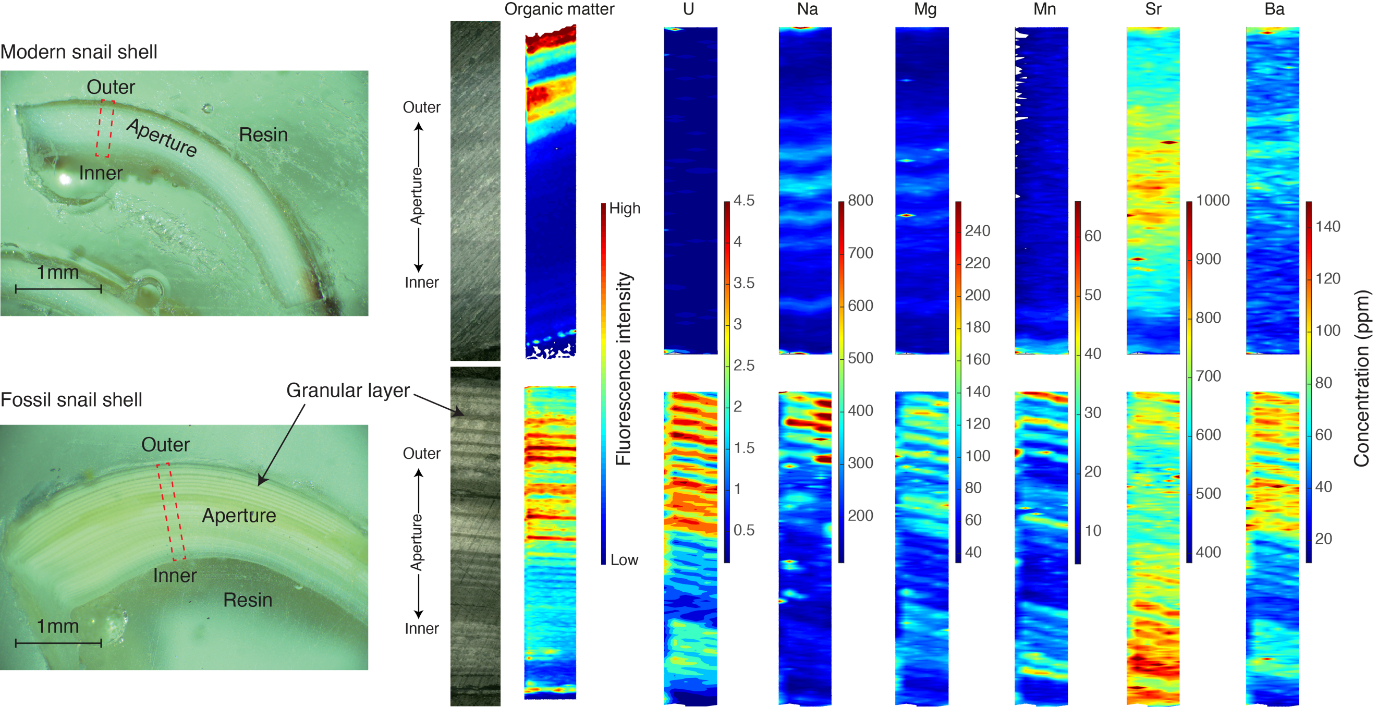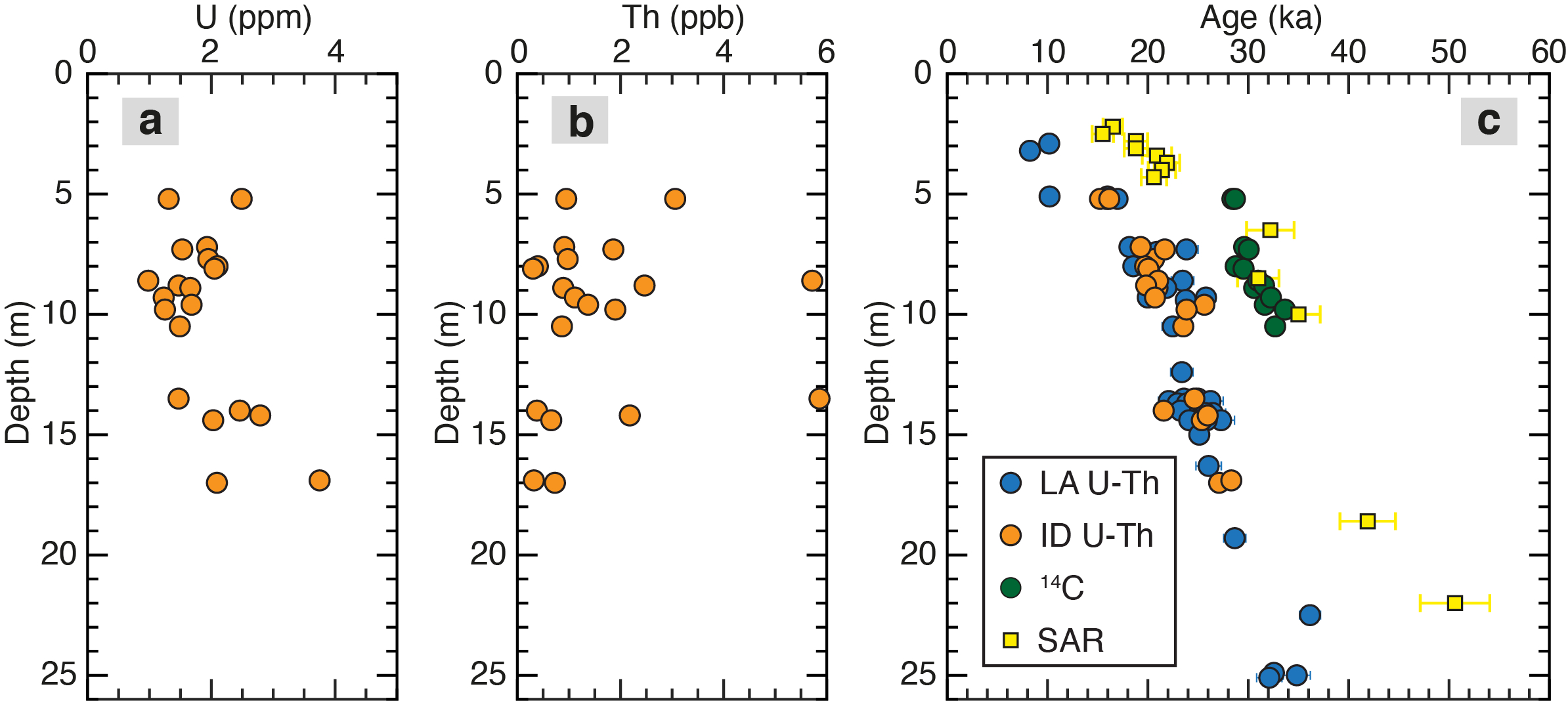Recently, Quaternary Geochronology published the first systematic investigation on the U-series isotope geochemistry as well as the early diagenetic imprints of fossil land snail shells (Cathaica sp.) from the Mangshan loess-paleosol sequence in Henan province, central China.
This study was conducted by Associate Professor LI Tao from the Nanjing Institute of Geology and Paleontology, Chinese Academy of Sciences (NIGPAS), in collaboration with Profs. CHEN Tianyu, LI Gaojun, LIU Yuanyuan, and Dr. WANG Maoyu from Nanjing University, and Prof. Robinson F. Laura and Dr. Knowles Tim from University of Bristol. Several geochemical techniques, including Raman microscopy, SEM, LA-ICPMS, LA-MC-ICPMS, solution-MC-ICPMS, and AMS 14C dating, were employed to investigate the mineralogy, chemical and isotopic compositions of both modern and fossil snail shells to micrometer level.
Terrestrial mollusks, which have been considered as typical "index animals" due to their sensitivity to climate change, are widely distributed in the semi-arid to arid region of China, such as Chinese Loess Plateau (CLP). So far, the assemblages of land snail fossils on the CLP have been used to prove the wind-blown origin of the Neogene loess sequences and red clay, and to reconstruct monsoonal environmental change in East Asia ranging from tectonic to orbital, and even millennial timescales. Growing studies have focused on the geochemical proxies recorded by their calcium carbonate shells, mainly including stable carbon (δ13C) and oxygen (δ18O) isotopes and clumped isotopes (Δ47).
Despite the wide application of these geochemical proxies of fossil snail shells in paleoclimatic reconstruction, it remains elusive to what extent they were influenced by the diagenetic alteration. No investigation has been conducted regarding the early diagenetic pathways which could alter the geochemical compositions of fossil land snail shells.
Another key advantage of land snail shells is that they can be absolutely dated by several methods, including 14C dating, electron spin resonance (ESR) dating, amino acid racemization (AAR) dating, and, potentially, U-Th dating, which helps to provide age constraints on loess deposits on the CLP. Among those geochronological approaches, U-Th dating is a very powerful technique due to its wide age coverage (0 to 640,000 years) and solid theoretical foundation.
However, obtaining accurate U-series dates from both marine and terrestrial mollusk shells has remained an outstanding issue for more than 50 years. A major challenge faced is that a significant amount of U in the shell is incorporated during the diagenetic episode after the burial of the shell into the sediment, suggesting apparent "open-system" behavior concerning the U-series disequilibrium. On the CLP where fossil snail shells can be buried and isolated quickly from the influence of meteoric water due to the relatively high sedimentation rate of eolian dust and the semi-arid to the arid climate, it is possible that diagenesis might occur only in the very early stage when pore-water is still able to alter the composition and structure of the snail shells. Therefore, land snail shells on the CLP may serve as a datable archive that can be used for U-Th dating. In turn, a clear understanding on the U-Th systematics of land snail shells would also help to constrain the reliability of shell-based geochemical proxies in paleoclimatic reconstructions.
Based on the Raman and SEM observations, it is clear that the fossil shell is characterized by an elevated degree of porosity and a higher content of organic matter. The trace elemental composition of the fossil Cathaica sp. shell has also been largely reset, which is linked to the diffusion and adsorption of organic matter into the fossil shell during the early diagenetic alternation of fossil Cathaica sp. shells.
U-series data acquired via LA-MC-ICPMS show that [234U/238U] and [230Th/238U] values are relatively homogeneous throughout the shell and the calculated apparent U-Th dates are within analytical error consistent with corresponding solution MC-ICPMS results, demonstrating the homogeneous distribution of [234U/238U] and [230Th/238U] within the fossil Cathaica sp. shells. However, the apparent closed system U-Th ages of fossil Cathaica sp. shells are found to be systematically younger (~6,000 to 13,000 years) than their paired shell 14C ages. By evaluating possible U uptake scenarios, this study suggests that this apparent age discrepancy is related to the early diagenetic uptake of U and later close system behavior likely due to the isolation of fossil shell from the influence of pore waters.
This research was supported by the National Natural Science Foundation of China, the Strategic Priority Research Program of the Chinese Academy of Sciences.
Reference: Li, T.*, Chen, T.*, Robinson, L.F., Wang, M., Li, G., Liu, Y., Knowles, T.D.J., 2023. Early diagenetic imprints and U-Th isotope systematics of fossil land snail shells from the Chinese Loess Plateau. Quaternary Geochronology 74, 101417. https://doi.org/10.1016/j.quageo.2022.101417.

Fig. 1 Raman fluorescence and elemental mapping across the aperture part of both modern and fossil Cathaica sp. shells.

Fig. 2 The depth profiles of (a) U concentration, (b) Th concentration and (c) apparent U-Th age and 14C age compared with published quartz SAR chronology for the Mangshan section.
Contact:
LIU Yun, Propagandist
Email: yunliu@nigpas.ac.cn
Nanjing Institute of Geology and Palaeontology, Chinese Academy of Sciences
Nanjing, Jiangsu 210008, China
Download:
